De-classified: What really happened to newspapers
The tech giants are often blamed for declines in revenue and the demise of traditional media, but is that really the case? Nic Hopkins, Google News Lab lead for Australia and New Zealand, looks at what really went wrong in the old business model for newspapers and whether it can be fixed.
In the mid-1990s the status of newspapers as the main source of news to society felt both indisputable and permanent.
The Internet was a novelty. We accessed the web on dial-up modems, surfed pages using Netscape and searched for information on Yahoo!, Excite and Lycos. Around the same time, across the Pacific, Amazon had only just launched an obscure online bookstore.
In 1995, I began my career as a journalist at The Advertiser in Adelaide. The web was so niche that there were fevered debates about whether we would need one “Internet terminal,” or perhaps two, for an entire newsroom.
Newspapers back then could afford to take their time with technology – there was no rush. They were unassailable and spectacularly profitable, thanks largely to classified advertising. Rupert Murdoch once described classifieds as “rivers of gold”.
Today, as we all know, the landscape is vastly different. The print rivers of gold have dried up, print circulation has sharply declined. On the face of it, the news business has never looked so vulnerable. To me, and anyone else who has worked in print or simply loves newspapers, this has been a painful process. My dad worked in newspapers – it’s in our blood.
What happened?
An analysis of the revenues of newspapers over nearly two decades, recently conducted for Google by the economists at AlphaBeta, is revealing – there is no mistaking precisely how and over what time period the old business model for newspapers broke.
In 2002, Australian newspapers collected 96% of all classified advertising, which amounted to $1.6 billion. By 2018, the total classified advertising market had grown to $1.9 billion, but only 12% of that was going to newspapers – the rest has splintered off to specialist online providers such as Domain, Realestate.com.au, Carsales and Seek.
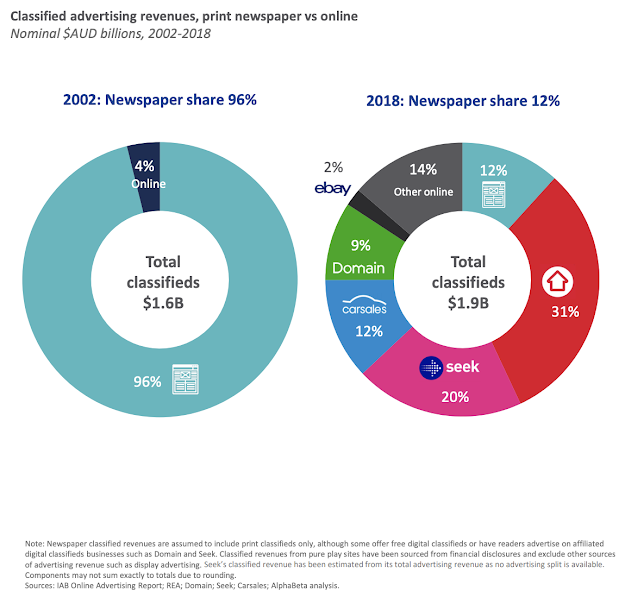
Source: AlphaBeta [click to enlarge]
Over that same period we moved from sitting at bulky desktop computers with slow connections to carrying a supercomputer in smartphone form, with instant access to news and information. Australian newspaper revenues peaked at $5.5 billion in 2007-08, just as Apple introduced the iPhone. The smartphone in our pocket, able to access the content news publishers made available for free on their websites, was almost a perfect disincentive to buying the next day’s newspaper. We now consume more news, but fewer newspapers.
That’s not all that has changed, of course. Over the same period we’ve seen the transformative development of search and social media platforms. Google launched ads in 2003, and it has grown to become a global business as the web itself has expanded to hundreds of billions of pages. Facebook was founded in 2004, and today almost 3 billion people use it to connect with each other around the world. Together they earn billions of dollars in revenue from commercial advertisers in Australia.
A widely held view is that if Google and Facebook didn’t exist, much of this revenue would have stayed with news publishers – that these tech platforms directly disrupted the newspaper business model. But AlphaBeta’s research disproves that theory: it wasn’t Google or Facebook specifically, it was technology in its entirety.
Search advertising is an entirely new category which allows businesses that would never have taken out a newspaper ad to reach specific audiences right at the instant they are seeking a product or service. And they only pay if a user actually clicks on their ad. Locally, Google’s advertising customers in Australia include a multitude of small and medium-sized businesses that never would have generated a substantial proportion of a newspaper’s income. If there is an incumbent publisher that has been disrupted by search ads, it’s directory operators like the Yellow Pages.
The total Australian advertising market almost doubled between 2002 and 2018 from $8.9 billion to $16.6 billion, and almost all of that growth came from search and social. But to suggest that that money would otherwise have gone to news publishers would require news publishers to have built their own search engines and social platforms. They didn’t.
Every time you use Gumtree to sell a bike, browse Domain for a place to live or flick through Carsales represents the flow of money away from newspapers. Major publishers still own large stakes in these digital classifieds businesses but the revenues no longer fund journalism.
However, the AlphaBeta study also offers hope. The business model that was broken is being re-made through technology: distribution, analytics, advertising, subscriptions. Reader contributions and subscriptions are transforming the economics of publishing news.
Today we spend greater amounts of time than ever before consuming the news, and there are many innovative new publishers finding readers that would have struggled to get a foothold in the days of the printing press. There are even green shoots of growth amid the COVID destruction – Telum Media reported this week that more than 30 new digital mastheads have emerged just this year.
In the quarter of a century since I first began as a fledgling print journalist the news industry has been radically, often painfully, transformed. It has taken years of trial and error, but there are paths that now lead to publishing profits and prosperity.
It’s my hope that Google can continue to support the news industry, through new products which pay publishers for high-quality content, and continue the work we have been doing for almost two decades in helping newsrooms to find new audiences, engage them with compelling stories and generate new income through digital channels.

Nic Hopkins is the Google News Lab lead for Australia and New Zealand. This post first appeared on the Google Australia blog and was republished with permission.

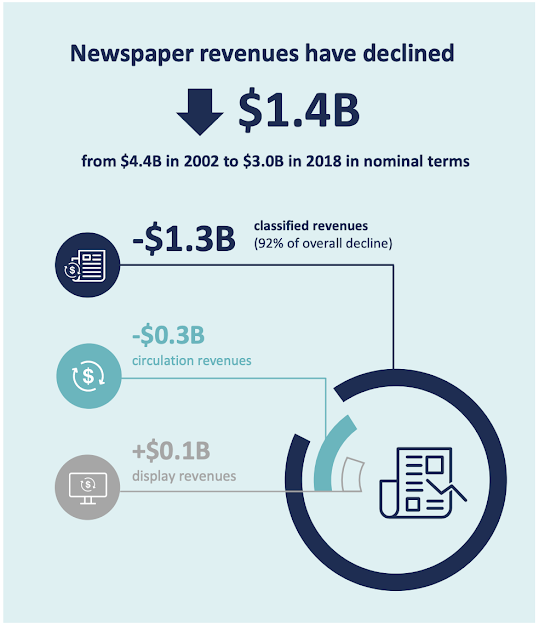
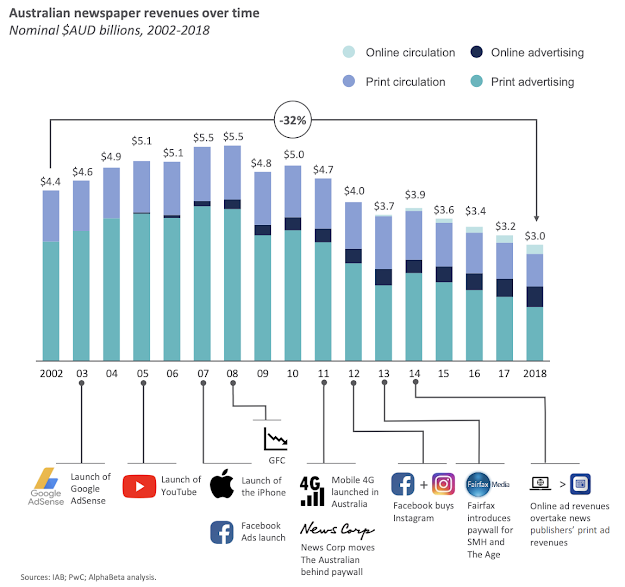
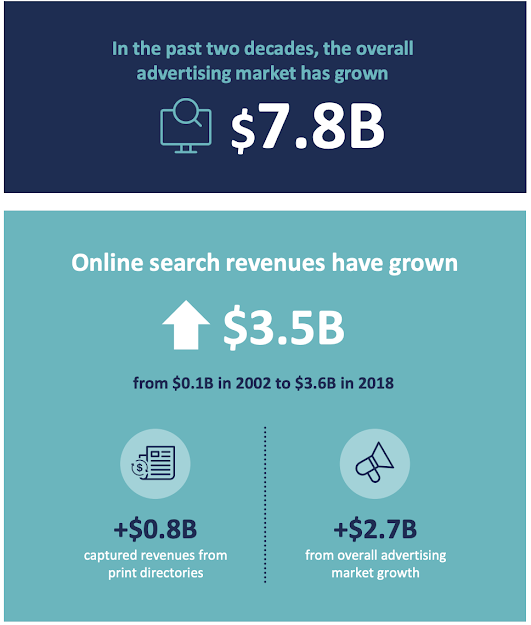
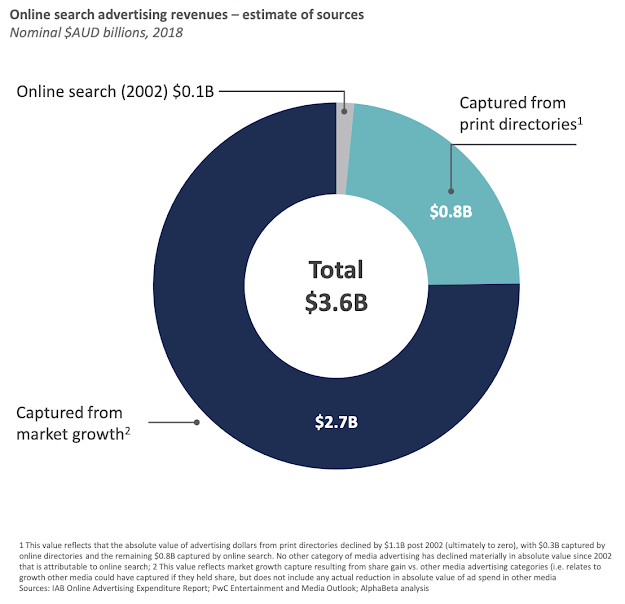
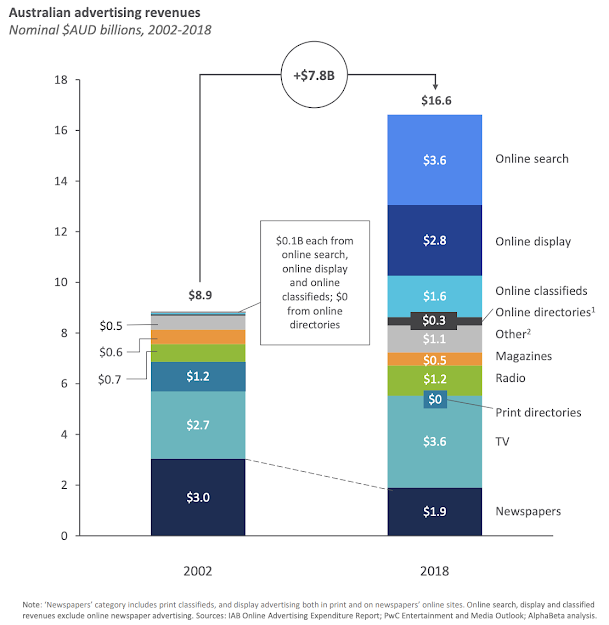
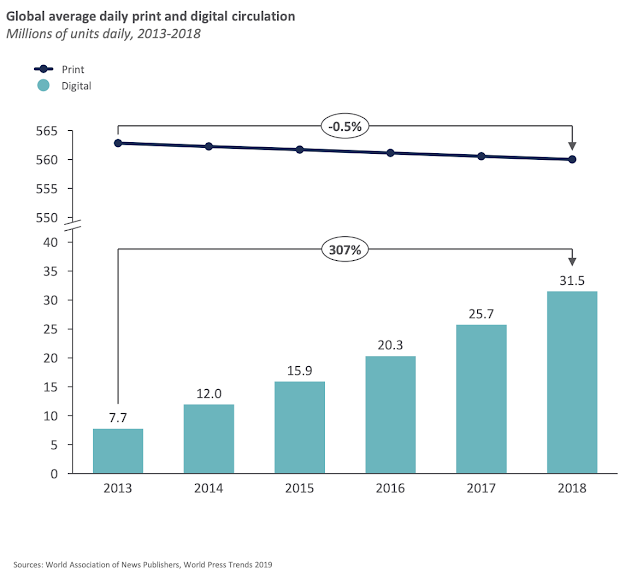

Great article well backed up with facts and stats.
Very good, rational piece backed up by good data. Clearly shows the argument that Goobook is to blame for publishers’ significant and ongoing revenue declines is spurious (to put it kindly). Per the data with this story, the biggest hit (by far) to publisher revenues is the money they have lost from classifieds , which has gone to the myriad
Of digital marketplace products That have been launched over the last 10-15 years. The publishers only have themselves to blame for missing that boat.
This data is all good — and correct. However, the analysis here ignores a major fact: Subscriptions and cover prices were NEVER enough to fund journalism in Australia. Not in the heyday of the print industry, not now. Display advertising and classified advertising always funded journalism. True, News Corp owns a 60% share in REA Group and Fairfax / Nine majority own Domain, but these are now independent entities, listed on the ASX, with shareholders who expect dividends and returns on their investment. They can’t use that money to fund journalism. So they need revenue from digital display advertising to fund their journalism, which they’re not getting as it’s going to Facebook and Google instead. In Europe or North America, where newspapers and magazines could be profitably off subs and cover prices, this analysis might fly. But not in Australia.
Sounds like they created a better product (Domain/REA), spun it off and damaged their core biz in the process. Again hardly a reason to invoice Google and Facebook!
First, News Corp was always an outsider investor in REA Group. The theory when they took their first stake was “better to compete with yourself than a rival.” A sound strategy, IMO.
Fairfax, which operated Domain, was a publicly traded company. Fairfax shareholders pushed the spin-off, in order to properly assess its value. (Likewise, this occurred with its ownership of Trade Me in NZ).
Second, look to the Nordics which have also spun off their classifieds businesses — Adevinta, the publicly traded holding company for Schibsted’s international classifieds businesses (which now owns Gumtree, including, yes Gumtree Australia), is massively profitable and was spun off from Schibsted, the media company. It’s not unusual for businesses to spin off their most profitable arms to create more value for shareholders.
But in the Nordics, the publishers have a massively diversified portfolio of companies, and have always been able to fund journalism through subs and cover prices.
The onus has always been on News and Fairfax to manage their own affairs and pay journalists accordingly, fairly and comprehensively.
If News organisations truly cared about their journalistic integrity and staff, they would have always been front and center of all decisions; not playing second-fiddle to shareholders.
If prioritising shareholder value is always paramount, then guess who loses..
The entire thing is a farce and News/Fairfax need to own their own mistakes.
As major shareholders, News Corp and Nine get dividends from REA and Domain too. They could choose use these to subsidise journalism.
Of course the economic argument for doing so is worse than it was in the old days when one part of the newspaper would subsidise the other. Though even then, I don’t know how many people bought Saturday’s paper for the news, then looked at the classifieds. At the time I had the impression that people would often buy that paper predominantly only for one half or the other.
I think sometimes people forget that people used to pay money to read classifieds.
Good article on advertising history, showing the importance of classified revenue to news media business model.
The only problem with this article is that the classified giants don’t really use journalistic content.
Google and Facebook do use it – and the argument is still sound that they should pay to use it otherwise the government will simply tax them to keep it going.
Hi Bob,
There is also a clear value exchange between news publishers and Facebook and Google. One could argue that news publishers actually benefit way more from having their content on Google and Facebook from the referrals they generate than the other way around. They also provide Google and Facebook with this content voluntarily. They could easily have it removed if it was a negative but choose not to.
To provide another analogy, if the internet didn’t exist and I were to have the ONLY billboard in town, and we allowed a shop down the road voluntarily put up a flyer each day for free advertising its products, and as a result we sent them 100 customers per day, is it fair for the shop to them turn around and say, you need to pay us for those customers you sent us and you need to pay us for the flyer we put up?
How do the publishers provide Google / FB with content voluntarily if a random person – like you, say – reads an article on their website and then shares it article on FB? Or searches something online and are referred by Google to their website?
You absolutely can argue they derive value from referral traffic, if were actually making money from digital display advertising, but they get but a whispers breath of display advertising revenue, with the majority going to Google / FB.
Yours is a flawed theory, champ.
Anyway, the thing everyone missed about the government making Google / FB pay publishers is that it has *nothing* to do with saving the media industry, and everything to do with watering down their market power. For another example, in the mid 90s when Microsoft got too powerful, the Clinton Administration filed an anti-trust lawsuit against them — nothing came of it, but the years it spent winding through the courts, did the trick. Eventually, there was another computing behemoth (Apple), and Microsoft was no longer controlling the software market.
“How do the publishers provide Google / FB with content voluntarily if a random person – like you, say – reads an article on their website and then shares it article on FB? Or searches something online and are referred by Google to their website?”
Regarding Facebook, you probably have a valid point, but regarding Google, every publisher can easily stop their website from being indexed by google with the simple addition of a couple of lines of code. It takes 5 mins. These publishers know this and are thus choosing to index their websites. If they don’t want them on Google, they can change that very quickly.
If the govt. was serious about reducing the monopoly power of Google or Facebook they could go after so many other areas of their business which are actually troubling. (Ie Google funnelling users to Google products at the expense of competitors on the search page). We all know this has nothing to do with that however, and is solely aimed at appeasing News Corp.
Thanks James.
They can easily noindex / block articles from showing in google through robots.txt and I believe you can request Facebook to remove a website’s content as well, as they have the ability to block particular domains or URLs. The publishers all voluntarily share their content with the platforms through Google Webmasters and as they also have Facebook Opengraph tags on all of their content for easy sharing on Facebook. They could change this but they choose not to.
I’m not arguing that Google and Facebook don’t get the lion’s share of advertising revenue. I’m arguing that they shouldn’t have to pay select news websites for displaying their content when the benefit is a net positive to the news websites. In other words, news publishers have a greater benefit from having their content on the platforms than Google or Facebook do. Hence why Facebook said they’ll just remove the news content as it’s of no real significance to them.
Whether or not Facebook or Google have too much power is a completely separate argument as to whether or not they should pay select news websites, which in essence will fast-track particular media organisation’s duopoly in what is a completely unfair competitive advantage. In my view, it’s anti-competitive in that it will create barriers to entry for new entrants in what should be a free and open media landscape in Australia.
I’m sorry, it’s not about that at all. News and Nine have stranglehold on print/online news in this country. That will not change with Facebook removing news.
They set the conversation with their headlines and with whatever stories they choose to publish.
This is about failure of them to adapt.
The argument is not so flawed. Every website can block it’s material appearing on Facebook or Google News when consumers share a link. Very few choose to. Most make a particular effort to make that content look as good it as it can, including all the major Australian news companies.
This is in part because they can’t so easily stop people taking screen grabs of news content on their phone, or copying and pasting material.
James – for your first point, and at least in the case of Google, publishers choose for their articles to be crawled and listed on Google. They can choose not to feature in Google search results (see question #2 here: https://australia.googleblog.com/2020/09/how-google-supports-news-industry.html), however none would do this because the traffic they receive from Google is huge.
When it comes to Facebook, try and find a news publisher which doesn’t have a Facebook page, and voluntarily posts their latest news stories to reach the audience on Facebook. They do, because FB allows them to distribute their articles for free… and now they expect FB to pay them for the privilege.
This argument doesn’t fly when you block the road and own the bus that takes people in and out of town.
No one can dispute the fact that digital has transformed media consumption in ways never though possible and in many cases for the better.
Regionally however, I believe the case to be a quite different. Digital serves regional locations very poorly and struggles to create a deep impression between the community and readers/audience. It has a role, but through recent experience it is a supporting one at best.
We recently launched a regional newspaper supported by digital and took a huge risk by reintroducing a significant level of local content with zero syndicated news. Digital is all over the syndicated big national news stuff along with TV. With 40 pages of genuine local content and a free circ model, readers have returned in droves. Not just ‘the oldies’ as they say, but people from across the board equally.
Significant high relevance local content + free distro delivers readers in droves and leaves a strong impression. We publish 12,000 copies per issue with a return rate below 300- 500. Our early evidence after 3 months is that a strong print product leads the conversation locally in ways digital never can due to it’s fleeting window of opportunity. Print, for us anyway, also delivers an intangible strength digital can’t compete with. This is the combined value of of all the content within the paper each issue driving other content within, as opposed to the isolated nature of a single news story being published online. This delivers stronger readership across all other content as opposed to the singular nature of consumption of articles in the digital space.
In our experience, which may not be everyone else’s, print amplify’s local stories first impression far better than digital/social can. Digital becomes very effective and valuable in carrying those conversations forward from there though.
Sure classifieds are no longer a big part of print, but that is something you just work around it to find alternative revenue sources.
The success so far will most likely lead us to launch other regional print titles.
I for one hope Google and Facebook do stop sharing news feeds. In our case anyway it would deliver even greater success for regional print media. There would be a downside though. That would however also deprive us of valuable digital platforms that clearly help support our print model.
With the garbage that newspapers report and the crappy sensationalism amoungst journalist these days, it’s not worth having.
Nice article. My two cents. From my experience, the major traditional print publishers had to be dragged kicking and screaming into the digital world. Their digital forays were tentative and ad hoc, constrained by a misguided belief that ‘print’ would prevail, and would ultimately prove to be their saviour. This prolonged reluctance to recognise that ‘print’ was terminally ill would have set them back significantly in the relevance race. Once the warning signs became too ominous to ignore, the investment and expertise that were deployed in an effort to play catch-up were woefully inadequate. None of this is the fault of Google, Facebook, Twitter, YouTube, Tik Tok, Instagram et al……
It’s pretty clear that the internet is the problem. Without that big news corporations would still have monopoly on news.
A ‘classified’ is a paid ad listing, valuable because it is matched to user intent.
In other words, exactly what Google search advertising is.
Newspapers would use news to pull readers to their classified products.
Google does the same with that news, except it doesn’t pay for it.
(And btw Nic, classifieds were by far and away funded by individuals and SMEs, especially in local papers. By up to 80%. You should ask the old commercial guys at the Advertiser.)
Similarly, news websites and apps advertise around their news content with digital display advertising. Facebook uses that news content, for free, to advertise around as well.
Despite the misleading definitions, graphs and ‘analysis’, it’s clear that Google and Facebook accessed the same advertising market, using the news publishers content – for free – to build monopolies with impunity. It’s amazing what you can do when you don’t pay for stuff and no-one stops you.
But now the time to finally pay the cheque has come.
As for the value the the monopolies give the publishers – “look how ungrateful our prisoners are of the food we give them, when we feel like it.”
PS – to all the 20/20 hindsight geniuses in the comments; I’m surprised you can be bothered to post from your private megayacht funded by all those tech stocks you invested in from day 1. Oh wait, you didn’t either did you?
“Newspapers would use news to pull readers to their classified products.
Google does the same with that news, except it doesn’t pay for it.”
Not so sure they do, actually — or not to any significant extent. For this to be true, then a high proportion of searches on Google would have to be from people looking for news content. According to Google, news-related searches only make up a small proportion of searches on their platform.
I just don’t think the publisher’s content – which they could pull from these platforms at any time – is as vitally important to goobook as the publishers think. On the other hand The value that Goobook drives for the publishers in terms of traffic is clear and significant.
The unanswered question/elephant in the room in this oped still remains: why won’t Google and Facebook pay a negotiated fair price to publishers for the journalism that millions of their users currently access on their platforms every day for free? And if providing access to it makes no difference to their business models then dump it, or invest in an alternative news service. Their arguments don’t wash until that happens.
“And if providing access to it [publisher content] makes no difference to their business models then dump it, or invest in an alternative news service.”
er, that’s exactly what Goobook are threatening to do: drop publisher news content from their platforms.
1. The ACCC’s report clearly states that Goog/FB do not steal/take content, otherwise this would be dealt with under the Copywrite Act.
2. The report also clearly states that Goog/FB generate minimal revenue directly from news content, as very few ads are served against news content.
3. The report says that news provides Goog/FB with incidental revenue streams based on user attention and ads served on other content, and because of market power, the news organisations can not negotiate for a slice of this ancilliary revenue. (Ironically, the proposed bill only helps the largest news organisations with this power imbalance and ignores the small).
4. So the crux of the issue is who needs who more? Does news drive ancilliary revenues to Goog/FB, or does Goog/FB drive ancilliary revenues to news organisations. One way to test this is to cut off the links and see who suffers more. Given the lengths to which the draft Bill goes to make it very, very difficult for Goog/FB to take these actions, I suspect the ACCC has a bit of a clue as to which way value flows.
Overall, once this is over, why wouldn’t News organisation go after the Newsagents?
News: You are taking our content and selling it, you need to pay for it.
Newsagents: You drop the papers at our door. We make very little money from selling them. People line up for lotto tickets, not newspapers. If you don’t like us displaying your papers to our customers, just stop leaving them on our doorstep.
News: Oh, OK. No, please keep showing our papers to customers. However, you make a lot of money selling lotto tickets. Give us some of that money.
Newsagents: WTF? No. That has nothing to do with you.
News: ACCC, please make the Newsagents give us some of the revenue they make from selling lotto tickets. The future of democracy is at stake. We don’t have any data to prove this, but we suspect most of what customers now spend on lotto tickets used to spent on classified ads in our paper asking anyone to send them $1M. Sure the customers have a better chance of getting $1M from lotto than just asking for it in a classified ad, but that’s not the point.
Good analogy
That is a very good analogy highlighting the government’s trying to pull a fast one on behalf of their mates while we are distracted.
Maybe China should get a commission on the COVID 19 news fodder.
While this article is correct in saying that jobs, real estate and cars classifieds went to Seek, REA and Carsales, it neglects to mention that directory advertising was always a big part of classifieds revenue too. Think plumbers, electricians, Jim’s mowing etc, which has all gone to Google search. Lucky News Corp has such a quality digital asset like buysearchsell.com.au to power them into their digital-first growth strategy and capture some of the online search market.
Publishers are doomed to fail unless they play ball with GooBook.
The reason is that GooBook haven’t just brought competition to the advertising side of the publisher model, these platforms have fundamentally shaken up how content is distributed.
It is the logistics of content distribution that publishers need to fix in order to maximise profitability, however in this day and age this is seemingly impossible.
Unless publishers unite to solve this problem, they will forever be at the mercy of external platforms like Google and Facebook who provide a low cost distribution channel for their content.
Did Domain ( part of the Nine network who one of the poor old, legacy news corporations) recently gain the wrong type of public exposure for creating and distributing fake news to it’s users?
Why don’t all parties work to build an attribution model similar to the advertising side? Surly with the complex tracking and reporting systems the digital players use, it would not be impossible. The smaller players keep functioning as they always have, but if you’re a large publisher, you build your links through a regulated platform, and the content is tracked and reported, that way there would be an accurate assessment of the value of publishers content to the platforms and traffic from the platforms back to the publishers, rev could be managed in a similar way APRA does music rights. If we’re managing to keep track of billions of dollars worth of advertising inventory it would not be impossible to think we could monitor and attribute the fair use of content amongst all parties?
Is this just a case of an Adelaide born company not investing enough to keep up with the rest of the world?
Q. Is it the product?
To compete, could legacy news providers not index their sites better so that users can find what they are looking for? In the olden days, Hitwise used to show that 70% of Aussies never went any further than the home pages of these legacy news companies. Ok, that was 2007 but I take a guess it hasn’t changed much. Hence, bye-bye highly converting classified users and HELLO Seek, Carsales, REA and Domain.
Q. Is it the commercials?
If Content used to be king, Conversions were craved for 20 years and now Context is today’s cure for all advertisers ailments how are legacy news companies adapting? Poorly [AU], unfortunately, as somewhere close to 90% of their users are not logged in to access news content, thus reducing the user pool to inform everything from UX through to micropayments. What are legacy news companies doing to encouraging users to exchange PI for a better experience? hello Seek, Carsales, REA, Domain and The Guardian who have nailed their multiscreen strategy [thus armed with universal ID’s]
Q. Is it the ad metrics?
Ad quality metrics made legacy CPMs redundant, it came to a head in the 2016 media upfront season. [see point 1] so some legacy news publishers found themselves with 11m uniques but only 40% of that had viewability scores higher than 75%. Hence, the folk on Chalmer, Windmill and Walker St now found 60% of a legacy publishers ads inventory now redundant.
Q. Call themselves True Blues! Is it the user’s fault?
Yeah but Nah. Why not make my subscription experience of The Oz as good as the NYT* and you will retain my attention and custom.
*NYT has reportedly grown paying subs from 500k to 5.7M in 8 years.
A google employee writing about Google funded research. It might all be objective but the public relations timing is, what’s a word that means both ‘transparent’ and ‘obvious’?